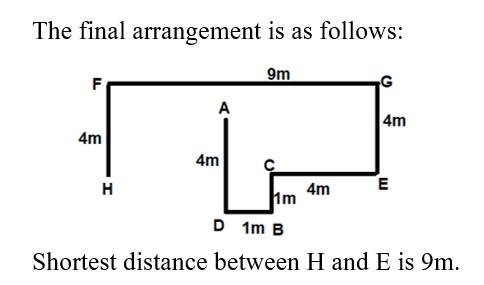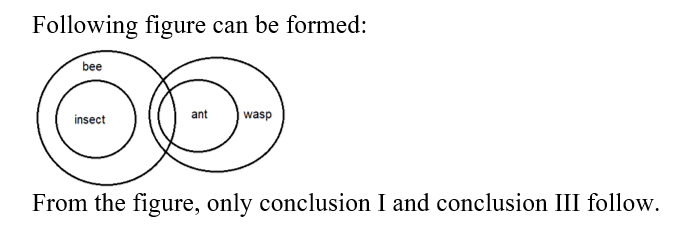Question 1:
In the question, assuming the given statements to be true, find which of the conclusion (s) among given three conclusions is /are definitely true and then give your answer accordingly.
निम्नलिखित प्रश्न में, दिए गए कथनों को सत्य मानकर, यह तय करना है कि दिए गए तीन निष्कर्षो में से कौन सा निष्कर्ष निश्चित रूप से सत्य है और फिर उसी अनुसार अपना उत्तर देना है।
Statements: G < R < K; A < N ≥ Y > R; V > K
Conclusions:
I. A < K
II. V > Y
III. G < V
Question 2:
In the question below there are four statements followed by three conclusions I, II and III. You have to take the three given statements to be true even if they seem to be at variance from commonly known facts and then decide which of the given conclusions logically follows from the four statements disregarding commonly known facts.
निम्नलिखित प्रश्न में चार कथन के बाद तीन निष्कर्ष I, II और III दिए गए हैं। आपको दिए गए कथन को सत्य मानना है भले ही वह ज्ञात तथ्यों से भिन्न भी हो और फिर यह तय करना है कि दिए गए निष्कर्षों में से कौन सा निष्कर्ष इन कथनों का तर्कसंगत अनुसरण करता है।
Statements: Some plant are tree.
कथन: कुछ प्लांट ट्री है।
All plant are bush.
सभी प्लांट बुश है।
No bush is grass.
कोई भी बुश ग्रास नहीं है।
Some bush are leaf.
कुछ बुश लीफ़ है।
Conclusions: I. Some tree are leaf.
निष्कर्ष: I. कुछ ट्री लीफ़ है।
II. No plant is grass.
II. कोई भी प्लांट ग्रास नहीं है।
III. Some leaf are plant.
III. कुछ leaf प्लांट है।
Question 3:
Directions : Answer the questions based on the information given below:
निर्देश: दिए गए जानकारी के आधार पर सवालों के उत्तर दें।
Eight items, A, B, C, D, E, F, G and H are placed at some distance from each other.
A is placed 4m north to D, which is 1m west to B, which is 1m south to C. H is placed 4m south to F, which is 9m west to G, which is 4m north to E. C is placed 4m west to E.
आठ वस्तु, A, B, C, D, E, F, G और H को एक दूसरे से कुछ दुरी पर रखा गया है।
A, D के 4मी उत्तर में है और D, B के 1मी पश्चिम में है और B, C के 1मी दक्षिण में है। H, F के 4मी दक्षिण में है और F, G के 9मी पश्चिम में है और G, E के 4मी उत्तर में है। C, E के 4मी पश्चिम में है।
What is the shortest distance between H and E?
H और E के बीच की न्यूनतम दूरी कितनी है?
Question 4:
Directions : Answer the questions based on the information given below:
निर्देश: दिए गए जानकारी के आधार पर सवालों के उत्तर दें।
Eight items, A, B, C, D, E, F, G and H are placed at some distance from each other.
A is placed 4m north to D, which is 1m west to B, which is 1m south to C. H is placed 4m south to F, which is 9m west to G, which is 4m north to E. C is placed 4m west to E.
आठ वस्तु, A, B, C, D, E, F, G और H को एक दूसरे से कुछ दुरी पर रखा गया है।
A, D के 4मी उत्तर में है और D, B के 1मी पश्चिम में है और B, C के 1मी दक्षिण में है। H, F के 4मी दक्षिण में है और F, G के 9मी पश्चिम में है और G, E के 4मी उत्तर में है। C, E के 4मी पश्चिम में है।
What is the direction of F with respect to C?
C के सन्दर्भ में F किस दिशा में है?
Question 5:
In the question below there are three statements followed by three conclusions I, II and III. You have to take the three given statements to be true even if they seem to be at variance from commonly known facts and then decide which of the given conclusions logically follows from the three statements disregarding commonly known facts.
निम्नलिखित प्रश्न में तीन कथन के बाद तीन निष्कर्ष I, II और III दिए गए हैं। आपको दिए गए कथन को सत्य मानना है भले ही वह ज्ञात तथ्यों से भिन्न भी हो और फिर यह तय करना है कि दिए गए निष्कर्षों में से कौन सा निष्कर्ष इन कथनों का तर्कसंगत अनुसरण करता है।
Statements: Only bee is insect.
कथन: केवल बी इन्सेक्ट है।
Some bee are ant.
कुछ बी एन्ट है।
Each ant is wasp.
प्रत्येक एन्ट वास्प है।
Conclusions: I. All insect are bee.
निष्कर्ष: I. सभी इन्सेक्ट बी है।
II. Some wasp are insect.
II. कुछ वास्प इन्सेक्ट है।
III. Some bee are wasp.
III. कुछ बी वास्प है।
Question 6:
‘A’ invested ₹4800 in business. ‘B’ joined the business 6 months after ‘A’ with a sum of ₹600 more than ‘A’. Find the profit share of ‘A’ out of total profit of ₹5600 at the end of 1.5 years.
'A' ने एक व्यवसाय में ₹4800 का निवेश किया।'A' के 6 महीने बाद 'B' ‘A’ की तुलना में ₹600 अधिक राशि के साथ व्यवसाय में शामिल होता है।1.5 वर्ष के अंत में ₹5600 के कुल लाभ में से ‘A’ का लाभ हिस्सा ज्ञात कीजिए।
Question 7:
Average weight of 20 students and 2 teachers is 42 kg. If both teachers are replaced by a 30 kg student, then average weight is decreased by 2 kg and ratio of weight of teachers is 1:2. What is the difference of the weight of both teachers?
20 छात्रों और 2 शिक्षकों का औसत वजन 42 किग्रा है। यदि दोनों शिक्षकों को 30 किग्रा के छात्र द्वारा प्रतिस्थापित किया जाता है, तो औसत वजन 2 किग्रा कम हो जाता है और शिक्षकों के वजन का अनुपात 1:2 है। दोनों शिक्षकों के वजन में कितना अंतर है?
Question 8:
The ratio of present ages of ‘A’ and ‘B’ is 7:4, respectively. ‘C’ is 14 years younger than ‘A’ while ‘D’ is 8 years younger than ‘B’. Find the ratio of present ages of ‘C’ and ‘D’.
'A' और 'B' की वर्तमान आयु का अनुपात क्रमशः 7:4 है। 'C' 'A' से 14 वर्ष छोटा है जबकि 'D' 'B' से 8 वर्ष छोटा है। 'C' और 'D' की वर्तमान आयु का अनुपात ज्ञात कीजिए।
Question 9:
A man spends 20% of his income on books, 15% of rest on travel and remaining in the ratio of 11:6 on education and video games, respectively. If the amount spent on video games is ₹12000 then find the amount spent by him on books.
एक व्यक्ति अपनी आय का 20% किताबों पर, शेष का 15% यात्रा पर और शेष को 11:6 के अनुपात में क्रमशः शिक्षा और वीडियो गेम पर खर्च करता है। यदि वीडियो गेम पर खर्च की गयी राशि ₹12000 है तो उसके द्वारा पुस्तकों पर खर्च की गयी राशि ज्ञात कीजिए।
Question 10:
Cost price of article ‘A’ is ₹200 more than that of article ‘B’. Article ‘A’ is sold at a loss of 20% while article ‘B’ is sold at a profit of 20%. If total selling price of both articles is ₹560, then cost price of article ‘A’ is:
वस्तु 'A' का क्रय मूल्य वस्तु 'B' से ₹200 अधिक है। वस्तु 'A' को 20% की हानि पर बेचा जाता है जबकि वस्तु 'B' को 20% के लाभ पर बेचा जाता है। यदि दोनों वस्तुओं का कुल विक्रय मूल्य ₹560 है, तो वस्तु 'A' का क्रय मूल्य कितना है:




